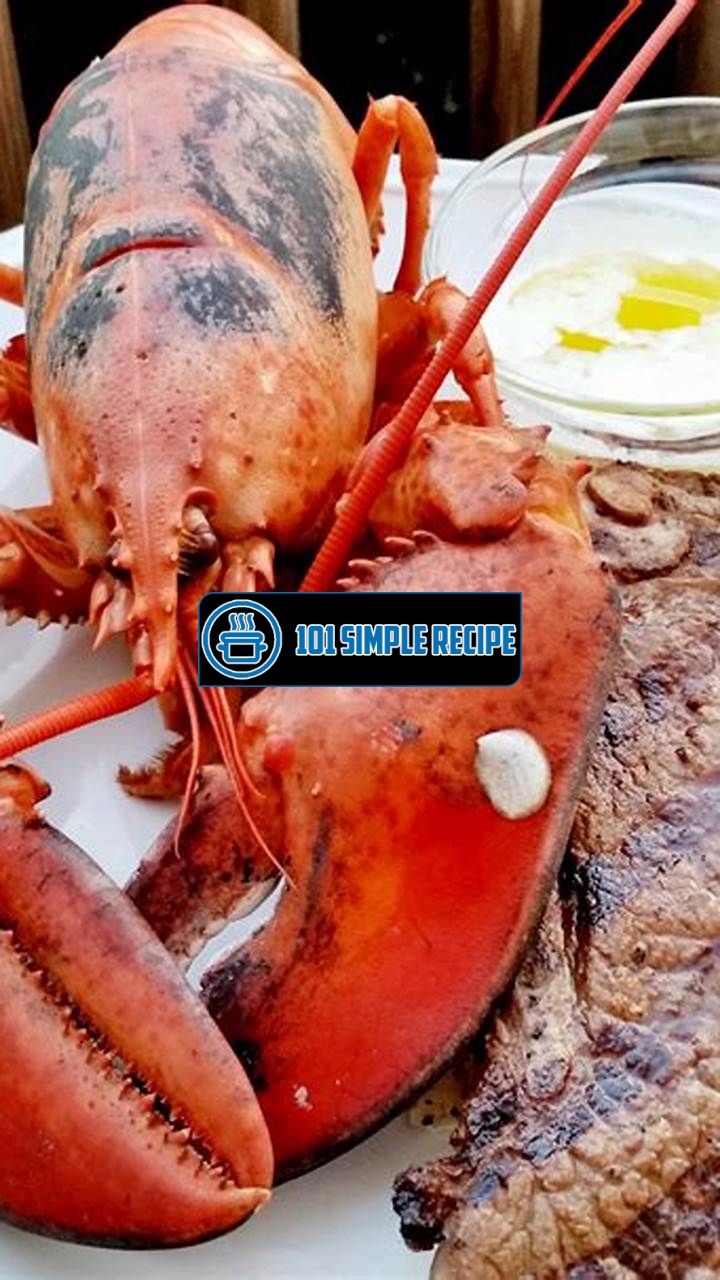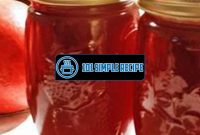Elevate your culinary skills to new heights with this incredible boil lobster recipe! Whether you are a seasoned chef or a beginner in the kitchen, this dish is sure to impress your guests and leave them craving for more. Imagine indulging in tender, succulent lobster meat with a heavenly combination of flavors. From the moment you take your first bite, you’ll be transported to the coastal shores where these delightful creatures thrive. So, get ready to dive into an unforgettable culinary experience that will make you the star of any gathering.

Choosing the Perfect Lobster
When it comes to preparing a delicious boiled lobster dish, selecting the right lobster is crucial. There are several key factors to consider to ensure your lobster is of the highest quality and perfectly suited for boiling. In this section, we will explore the importance of freshness and quality, as well as the considerations for size and quantity in choosing the perfect lobster. Additionally, we will discuss specific factors to keep in mind when opting for live lobsters.
Freshness and Quality
The freshness and quality of the lobster you choose directly impacts the taste and texture of the final dish. When selecting a lobster for boiling, freshness should be your top priority. Here are a few tips to help you determine whether a lobster is fresh:
- Look for lobsters that are lively and active. Active lobsters are usually healthier and have a better flavor.
- Inspect the shell for any signs of damage or discoloration. Fresh lobsters will have a vibrant, unblemished shell.
- Check the antennae of the lobster. They should be intact and moving, indicating a live lobster.
- Consider purchasing lobsters from a reputable seafood market or supplier known for their high-quality products. This ensures you are getting the freshest lobsters available.
Size and Quantity
The size and quantity of lobsters you need will depend on various factors such as the number of servings you want to prepare and your personal preferences. Here are some factors to consider:
- If you are serving lobster as the main course, plan on approximately one to two pounds of lobster per person.
- Smaller lobsters, typically weighing around one to one and a half pounds, are generally more tender and have a sweeter flavor.
- For a larger gathering or if you want leftovers, you may need to purchase multiple lobsters.
- Keep in mind that larger lobsters may require longer cooking times.
Considerations for Live Lobsters
If you opt for live lobsters, there are a few additional considerations to keep in mind:
It is essential to handle live lobsters with care and ensure their welfare until they are ready for boiling. Store live lobsters in a cool, damp environment, such as the refrigerator, until you are ready to cook them. Avoid storing lobsters in fresh water as they can die from lack of oxygen. It’s best to cook live lobsters on the same day you purchase them to guarantee freshness and flavor.
By taking into account the factors of freshness and quality, size and quantity, and making considerations for live lobsters, you can elevate your culinary skills and create a delightful boiled lobster recipe that will impress your guests. So go ahead, choose your lobsters wisely, and get ready to indulge in a mouthwatering seafood feast!
Preparation Before Boiling
If you’re looking to elevate your culinary skills and impress your guests with a mouthwatering boil lobster recipe, it’s important to take the necessary steps before you start boiling your lobster. By properly cleaning and handling the lobsters, preparing the cooking environment, and potentially taking some optional pre-boiling steps, you can ensure the best results and a delicious outcome.
Cleaning and Handling Lobsters
Before diving into the cooking process, it’s essential to clean and handle your lobsters properly. This ensures that you remove any impurities and guarantees the safety and quality of the dish.
To clean the lobsters, start by rinsing them under cold water. Make sure to remove any dirt or debris that may be present. It’s also important to check the lobsters for any signs of damage or dead lobsters. If you come across a dead lobster, discard it as it is not safe for consumption.
Once the lobsters are clean, you can proceed to handle them with care. Hold them firmly but gently, making sure to avoid any sudden movements that may startle the lobsters. This helps to minimize stress and potential harm to both you and the lobsters.
Preparing the Cooking Environment
The cooking environment plays a crucial role in ensuring the success of your boil lobster recipe. Creating the right atmosphere will enhance the flavors and allow for optimal cooking. Here are a few steps to prepare the cooking environment:
- Gather the necessary equipment: Start by collecting all the required utensils and equipment. This may include a large pot for boiling, a strainer or slotted spoon for removing the lobsters from the water, and a cutting board and knife for any additional preparations.
- Set up a clean workspace: Clear your workspace from any clutter and ensure it is clean and sanitized. This helps to maintain hygiene and prevents any cross-contamination.
- Organize your ingredients: Have all the ingredients for your boil lobster recipe readily available. This includes any herbs, spices, or additional seasonings you plan to use.
- Prepare the cooking liquid: Fill the pot with enough water to completely cover the lobsters. Adding salt and any other desired seasonings to the water will impart flavor into the meat as it cooks.
Optional Pre-Boiling Steps
In addition to the essential cleaning and preparation steps, there are a few optional pre-boiling steps you can take to further enhance the flavor and texture of your lobsters:
- Blanching: Some chefs recommend blanching the lobsters briefly in boiling water before the actual boiling process. This helps to loosen the shell and makes it easier to remove once cooked.
- Cracking the claws: For easier consumption and to allow the flavor to penetrate the meat, you can crack the claws slightly before boiling. This also prevents the claws from curling up during the cooking process.
- Marinating: To infuse additional flavors into the lobster meat, consider marinating it beforehand. This can be done with a mixture of herbs, spices, and a small amount of oil or butter.
By following these important preparation steps, you’ll be well on your way to creating a delightful boil lobster recipe. Remember to handle the lobsters with care, prepare the cooking environment properly, and consider any optional pre-boiling steps to elevate your culinary skills and impress your guests with a tantalizing dish.
Boiling the Lobster
Master the art of boiling a lobster to achieve perfectly cooked meat every time. Boiling is a popular method for cooking lobster because it is simple and allows the natural flavors of the lobster to shine. With the right technique, you can enjoy a succulent and flavorful lobster dish at home.
Boiling Water and Salt Ratio
Before boiling the lobster, it is important to prepare the water by achieving the perfect salt ratio. The ratio of salt to water can enhance the flavor of the lobster meat. For every gallon of water, it is recommended to add 2 tablespoons of salt. This will help season the lobster as it cooks and give it a delicious taste. So remember, for every gallon of water, add 2 tablespoons of salt .
Determining Cooking Time
Cooking time is crucial when boiling lobster to ensure that the meat is cooked to perfection. The general rule of thumb is to cook the lobster for about 9-12 minutes per pound. However, it is important to keep in mind that the cooking time may vary depending on the size of the lobster and personal preference. Larger lobsters will require more cooking time, while smaller ones may be ready in less time. The lobster shell should also turn a bright red color, indicating that it is fully cooked. So make sure to cook the lobster for the appropriate amount of time ⏰.
It is worth noting that overcooking can lead to tough and rubbery lobster meat, while undercooking may result in raw or undercooked sections. So keep a close eye on the cooking process and use a timer to ensure that you achieve the perfect texture and taste.
Methods for Immersion and Cooking
When it comes to boiling lobster, there are a few methods you can choose from for immersion and cooking. The traditional method involves submerging the lobsters completely in boiling water. This ensures even cooking and allows the flavors to infuse into the meat. You can also add aromatic herbs or spices to the boiling water to enhance the taste.
Another method is the steaming method, where you place a steaming rack or basket in a pot with a small amount of water. The lobsters are placed on the rack and covered, allowing the steam to cook them. This method can help retain the natural juices and flavors of the lobster meat.
Regardless of the method you choose, it is important to handle the lobster with care and ensure that it is cooked to the appropriate temperature to avoid any risk of foodborne illnesses. Using a meat thermometer can help you gauge the doneness of the lobster. The internal temperature should reach 145°F (63°C) to ensure it is safe to consume.
So whether you opt for the traditional method of immersing the lobster in boiling water or the steaming method, the key is to follow proper cooking techniques and times to elevate your culinary skills and enjoy a delicious boil lobster recipe .
Serving and Enjoying Lobster
When it comes to elevating your culinary skills, few dishes can compare to a perfectly boiled lobster. Whether you’re a seafood aficionado or simply looking to impress your dinner guests, mastering the art of cooking and serving lobster is a must. In this article, we will explore different serving options and accompanying dishes that will enhance your lobster meal and leave your taste buds craving for more.
Classic Lobster Serving Style
The classic lobster serving style is ubiquitous for a reason – it’s simple, delicious, and allows the natural flavors of the lobster to shine. To serve lobster in the classic style, you’ll need some melted butter, lemon wedges, and a bib (trust us, it can get messy!).
Start by cracking the lobster shell with a lobster cracker or a nutcracker. Carefully remove the meat from the shell and dip it into the melted butter for a burst of indulgence. Squeeze some fresh lemon juice over the meat to enhance its natural sweetness.
The beauty of the classic lobster serving style lies in its simplicity. By keeping the focus on the lobster itself, you can fully appreciate the delicate texture and rich taste of this exquisite seafood.
Popular Lobster Side Dishes
While lobster undoubtedly takes center stage, the right side dishes can complement and enhance the overall flavor profile of your meal. Here are a few popular lobster side dishes that will take your culinary experience to the next level:
- Garlic Butter Roasted Potatoes: These crispy, golden potatoes seasoned with garlic and butter make the perfect accompaniment to your lobster feast. The combination of the rich, buttery flavors with the succulent lobster meat is simply heavenly.
- Corn on the Cob: Sweet and juicy, corn on the cob adds a burst of freshness to your meal. Boil it, grill it, or roast it – the choice is yours. Just be sure to slather it with some melted butter for that extra touch of indulgence.
- Grilled Asparagus: Lightly charred and seasoned with a hint of lemon zest, grilled asparagus adds a touch of elegance to your lobster dinner. Its vibrant green color and crisp texture are the perfect contrast to the tender lobster meat.
Enhancements and Seasonings
While lobster is undeniably delicious on its own, a little extra seasoning and enhancement can take it to new heights. Here are a few ideas to enhance the flavor of your lobster:
- Herb Butter: Create a savory blend of herbs like parsley, tarragon, and chives mixed with melted butter. Spread it generously over your lobster meat for an explosion of flavors.
- Spicy Cajun Seasoning: If you like a kick of heat, sprinkle some spicy Cajun seasoning over your lobster. The combination of the spicy seasoning and the sweet, succulent meat is a match made in heaven.
- Truffle Oil Drizzle: For an indulgent twist, drizzle some truffle oil over your cooked lobster. The earthy aroma and rich flavor of truffles will elevate your lobster to a gourmet level.
So, whether you prefer to keep it classic or experiment with different flavors, serving and enjoying lobster is a culinary experience like no other. With the right accompaniments and seasonings, you can elevate your lobster meal to new heights and create a feast that will be remembered for years to come.
Troubleshooting and Tips
When it comes to boiling lobster, there are a few common issues that can arise. However, with the right tips and solutions, you can ensure a successful outcome every time. Whether you’ve experienced overcooking or undercooking issues or find yourself dealing with tough lobster meat, we have you covered. Additionally, we’ll share some expert tips for enhancing the flavor and texture of your boiled lobster.
Overcooking and Undercooking Fixes
One of the biggest challenges when boiling lobster is achieving the perfect level of doneness. Overcooking can result in tough, rubbery meat, while undercooking can leave you with raw and unpleasant flavors. To avoid these issues, here are some fixes:
- Timing is crucial: Follow the recommended cooking times based on the size of your lobster. A general rule of thumb is to boil a one-pound lobster for about 8-10 minutes.
- Test for doneness: To check if your lobster is cooked to perfection, insert a skewer or a knife into the thickest part of the tail. If the meat is opaque and firm, it’s ready. If it appears translucent and jiggles, it needs more time.
- Adjust cooking time: If you’ve overcooked your lobster and it has become tough, try reducing the cooking time by a few minutes in your next attempt. If it’s undercooked, simply increase the cooking time by a couple of minutes.
Note: Achieving the ideal level of doneness may take some practice, so don’t be discouraged if your first try isn’t perfect. With time, you’ll master the art of boiling lobster to perfection.
Dealing with Tough Lobster Meat
There can be instances where the lobster meat turns out tough, even when it has been cooked for the appropriate amount of time. Here are some tips to combat this issue:
- Steam before boiling: Many chefs recommend steaming the lobster for a few minutes before plunging it into boiling water. This pre-steam process helps tenderize the meat and preserve its juicy texture.
- Use fresh lobsters: Opt for fresh lobsters to ensure the best quality and tenderness. Avoid purchasing lobsters that have been frozen for an extended period, as they may lose some of their natural moisture.
- Cook at the right temperature: Maintain a gentle boil while cooking the lobster. A rolling boil can result in tougher meat, so it’s important to find the right balance.
Note: If you find yourself consistently encountering tough lobster meat, consider experimenting with different cooking techniques, such as grilling or baking, to achieve a more desirable texture.
Expert Tips for Flavor and Texture
Now that you have a handle on troubleshooting common issues and achieving the perfect doneness, let’s explore some expert tips for enhancing the flavor and texture of your boiled lobster:
- Season the cooking water: Add flavors to your lobster by seasoning the boiling water with spices, herbs, or even a splash of white wine. This will infuse the meat with subtle and delicious aromas.
- Chill before serving: Once your lobster is cooked, let it cool in an ice bath or under cold running water. This not only stops the cooking process but also helps the meat retain its delicate texture.
- Serve with complementary sauces: Elevate the taste of your boiled lobster by serving it with melted butter, garlic aioli, or a tangy lemon mayonnaise. These sauces add an extra dimension of flavor.
Note: Don’t be afraid to experiment with different seasoning blends, sauces, and cooking methods to find your personal favorite way of enjoying boiled lobster.
By following these troubleshooting tips and implementing expert advice, you’ll be able to elevate your culinary skills and create a perfect boil lobster recipe every time. So, get ready to impress your family and friends with a deliciously cooked lobster dish that will leave them wanting more!
Frequently Asked Questions
We hope you found this “boil lobster recipe” article helpful in mastering the art of cooking delicious lobsters. Below are some frequently asked questions that may provide further clarification:
| No. | Questions | Answers |
|---|---|---|
| 1. | How do I determine the cooking time for different lobster sizes? | The general rule is to cook lobsters for approximately one minute per ounce. So, a 1-pound lobster would be cooked for about 8-10 minutes. Adjust the cooking time accordingly for larger or smaller lobsters. |
| 2. | Can I use frozen lobsters for this recipe? | Yes, you can use frozen lobsters. However, make sure to thaw them thoroughly before boiling to ensure even cooking. |
| 3. | Do I need to add salt to the boiling water? | Yes, adding salt to the boiling water helps enhance the flavor of the lobster meat. Aim for about 1-2 tablespoons of salt per gallon of water. |
| 4. | How can I tell if the lobster is fully cooked? | A fully cooked lobster will have a bright red shell and the meat will be opaque. The internal temperature should reach 145°F (63°C) to ensure it is safe to eat. |
| 5. | Can I add other seasonings to the boiling water? | Absolutely! You can add bay leaves, garlic, lemon slices, or other herbs and spices to infuse additional flavors into the lobster meat. |
| 6. | What are some serving suggestions for boiled lobster? | Boiled lobster is delicious on its own, but you can serve it with melted butter, lemon wedges, or a side of clarified butter for dipping. |
Thank You for Joining Us!
We hope you enjoyed reading our article on how to boil lobster. Now that you have mastered this classic seafood dish, you can impress your friends and family with your culinary skills. Remember, practice makes perfect, so don’t be afraid to try different flavors and variations. If you have any other questions or need further assistance, feel free to visit our website again later. Happy cooking!
Jump to Recipe
Boil Lobster Recipe

Learn how to perfectly boil lobsters with this easy and flavorful recipe. Impress your guests with tender and juicy lobster meat!
- 2 live lobsters (1 pound each)
- 2 tablespoons salt
- Water
- Fill a large pot with enough water to fully submerge the lobsters. Add the salt and bring the water to a rolling boil.
- Gently place the live lobsters into the boiling water, headfirst. Cover the pot and cook for 8-10 minutes, or until the lobsters are bright red.
- Using tongs, carefully remove the cooked lobsters from the boiling water and transfer them to a plate or serving dish.
- Serve the boiled lobsters hot with melted butter, lemon wedges, or your favorite dipping sauce. Enjoy!






